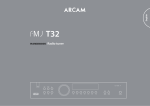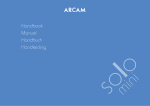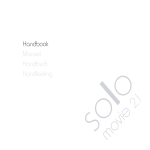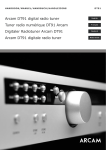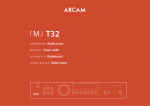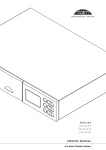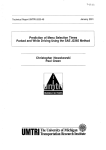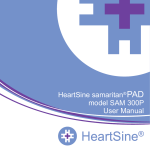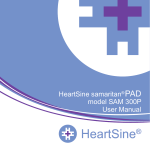Download Arcam Solo Music
Transcript
Handbook Manuel Handbuch Handleiding safety guidelines CAUTION ATTENTION RISK OF ELECTRIC SHOCK DO NOT OPEN RISQUE DE CHOC ELECTRIQUE NE PAS OUVRIR CAUTION: To reduce the risk of electric shock, do not remove cover (or back). No user serviceable parts inside. Refer servicing to qualified service personnel. WARNING: To reduce the risk of fire or electric shock, do not expose this apparatus to rain or moisture. The lightning flash with an arrowhead symbol within an equilateral triangle, is intended to alert the user to the presence of uninsulated ‘dangerous voltage’ within the product’s enclosure that may be of sufficient magnitude to constitute a risk of electric shock to persons. The exclamation point within an equilateral triangle is intended to alert the user to the presence of important operating and maintenance (servicing) instructions in the literature accompanying the product. CAUTION: In Canada and the USA, to prevent electric shock, match the wide blade of the plug to the wide slot in the socket and insert the plug fully into the socket. Important safety instructions This product is designed and manufactured to meet strict quality and safety standards. However, you should be aware of the following installation and operation precautions. 8. Cleaning 14. Abnormal smell Unplug the unit from the mains supply before cleaning. If an abnormal smell or smoke is detected from the appliance, turn the power off immediately and unplug the unit from the wall outlet. Contact your dealer immediately. The case should normally only require a wipe with a soft, damp, lint-free cloth. Do not use paint thinners or other chemical solvents for cleaning. 1. Take heed of warnings and instructions You should read all the safety and operating instructions before operating this appliance. Retain this handbook for future reference and adhere to all warnings in the handbook or on the appliance. 2. Water and moisture The presence of electricity near water can be dangerous. Do not use the appliance near water – for example next to a bathtub, washbowl, kitchen sink, in a wet basement or near a swimming pool, etc. You should not attempt to service the appliance beyond that described in this handbook. All other servicing should be referred to qualified service personnel. 9. Power sources 16. Damage requiring service Only connect the appliance to a power supply of the type described in the operating instructions or as marked on the appliance. The appliance should be serviced by qualified service personnel when: A. the power-supply cord or the plug has been damaged, or This is a Class 1 device and must be earthed. 3. Object or liquid entry The primary method of isolating Solo from the mains supply is to use the switch on the rear of Solo. Solo must be installed in manner that makes disconnection possible. Take care that objects do not fall and liquids are not spilled into the enclosure through any openings. Liquid-filled objects such as vases should not be placed on the equipment. 10. Power-cord protection 4. Ventilation Power supply cords should be routed so that they are not likely to be walked on or pinched by items placed upon or against them, paying particular attention to cords and plugs, and the point where they exit from the appliance. Do not place the equipment on a bed, sofa, rug or similar soft surface, or in an enclosed bookcase or cabinet, since ventilation may be impeded. We recommend a minimum distance of 50mm around the sides and top of the appliance to provide adequate ventilation. 11. Grounding Ensure that the grounding means of the appliance is not defeated. 5. Heat Locate the appliance away from naked flames or heat producing equipment such as radiators, stoves or other appliances (including other amplifiers) that produce heat. 12. Power lines Locate any outdoor antenna/aerial away from power lines. 13. Non-use periods 6. Climate If the unit has a stand-by function, a small amount of current will continue to flow into the equipment in this mode. Unplug the power cord of the appliance from the outlet if left unused for a long period of time. The appliance has been designed for use in moderate climates. 7. Racks and stands Only use a rack or stand that is recommended for use with audio equipment. If the equipment is on a portable rack it should be moved with great care, to avoid overturning the combination. E2 15. Servicing We do not advise the use of furniture cleaning sprays or polishes as they can cause indelible white marks if the unit is subsequently wiped with a damp cloth. B. objects have fallen, or liquid has spilled into the appliance, or C. the appliance has been exposed to rain, or D. the appliance does not appear to operate normally or exhibits a marked change in performance, or E. the appliance has been dropped or the enclosure damaged. 17. Speaker connections Any speakers must be connected to Solo using Class 2 wire (i.e., no connection to earth should be made). Failure to observe this precaution may cause Solo to be damaged. Safety compliance This product has been designed to meet the IEC 60065 international electrical safety standard. English welcome… … and thank you for purchasing the Arcam Solo music system. Arcam has been producing high-quality audio components for nearly thirty years. During that time we have amassed a wealth of knowledge on both the design and construction of audio components in order to give the best sound performance for the price. The design of Solo is a distillation of this knowledge into an easy-to-use package that is intended to give you years of listening enjoyment while taking just a few minutes to learn how to use. Contents safety guidelines ..................................................... E2 welcome…............................................................... E3 making connections................................................ E4 making music .......................................................... E5 remote control......................................................... E6 This handbook is intended to give you a detailed guide of the use of the Solo music system. Overleaf, you will find a ‘quick start’ guide that should be sufficient for most users; further into the handbook you will find additional information on the more advanced features. using the radio ........................................................ E7 We hope that your Solo music system will give you years of trouble-free operation. In the unlikely event of any fault, or if you simply require further information about Arcam products, our network of dealers will be happy to help you. Further information can be found on the Arcam web-site at www.arcam.co.uk. product guarantee ................................................ E14 The Solo development team installation guidelines ............................................ E8 advanced features................................................. E11 technical specification .......................................... E13 Safety Safety guidelines are set out on page 2 of this handbook. Many of these items are common sense precautions but, for your own safety and to ensure that you do not damage the unit, we recommend that you read them. This product requires an earth connection. Turn to pages 4 & 5 for a quick-start guide to Solo… E3 Introduction This page gives a quick overview of the installation process for Solo. For more detailed instructions on each of the items below, please see the “Installation Guidelines” section of this handbook, starting on page 8. making connections Radio aerial In Europe and Canada, Solo is usually fitted with a combined FM/DAB (digital radio) receiver module; in the USA and the Far East, an AM/FM receiver module is usually supplied. In order to use either of these modules, you must connect an aerial to the unit – a suitable aerial is supplied as an accessory. The FM/DAB aerial connector is an F-type (screw) connector. The aerial should be connected to this input by pushing the pin into the hole in the centre of the connector, then screwing the sleeve onto the outside. The AM aerial should be connected as described on page 9. Remote control connectors To use the supplied ‘T’ shaped wire aerial, mount it as high up as possible on a wall with the elements positioned vertically. If accessable, try each usable wall of the room to see which gives the best reception. Use tacks or adhesive tape to secure the aerial to the wall, but ensure that tacks do not come into contact with the internal wire of the aerial. These connections are intended for use in multiroom installations and are unlikely to be used in most cases. Further information can be found on page 9. For optimal reception, the use of a roof-mounted (external) aerial is recommended (see page 10). RS232 REMOTE PROGRAM OUT 12V TRIGGER 230V ~ 50 – 60HZ xxW MAX IN ZONE 2 FM L AM GND IN LOCAL ZONE 2 PRE OUT TAPE OUT TAPE IN SPEAKER OUTPUT GAME TV AV IN L CD OUT R R SERIAL NO. Power Speakers Audio outputs Audio inputs Solo is supplied with a moulded mains plug already fitted to the lead. Check that the plug supplied fits your supply – should you require a new mains lead, please contact your Arcam dealer. In order to hear any sound from Solo, you must connect speakers to it. Solo is designed to drive a single pair of speakers, rated between 4 and 8 ohms, and is fitted with speaker terminals that can accept either spade terminals or bare wires. Pre-out If you wish, Solo can be used as a high-quality amplifier for other audio sources. Five audio inputs are provided for this purpose (one is on the frontpanel). Push the IEC (kettle-style) plug end of the power cable into the socket on the back of Solo, making sure that it is pushed in firmly. Put the plug on the other end of the cable into your power supply socket and, if necessary, switch the socket on. Solo is fitted with a power switch on the rear of the product, next to the power inlet. To use Solo, make sure that this is switched on. Solo is fitted with a transformer designed to accept the mains voltage in the region that the product was shipped to. If your mains supply voltage does not match this specification (as shown on the rear panel), you wish to take the unit to a region with a different main voltage, or the mains plug is incorrect, please consult your Arcam dealer. This product must be earthed. These connectors carry the output of the pre-amp. stage of Solo. If you wish to use an external power amp. with Solo, connect these outputs to the inputs of your power amp. See page 9 for further details. To connect the left speaker, unscrew the terminals on the back of Solo labelled L, insert the speaker wire (or spade) and screw the terminals back up. Make sure that the red (positive/+) terminal of the speaker is connected to the red terminal on Solo and the black (negative/–) terminal of the speaker is connected to the black terminal on Solo. Repeat the above to connect the right speaker to the terminals labelled R. Zone 2 These connectors carry the output of the pre-amp. for Zone 2. For more information on using Zone 2, please turn to page 8. CD out This is an optical connection that carries the digital audio stream from a CD or from the DAB radio (where fitted). It is intended to allow recording of CDs/DAB to MiniDisc, or similar. It is important that no stray strands of wire from these connections are allowed to touch another cable or the product casing. Failure to ensure this can cause a short circuit, and damage to your Solo. Connect this output to the optical input of your recording device. Further details can be found on page 9. Do not over-tighten the loudspeaker terminals, or use a wrench, pliers, etc., as this could cause damage to the terminals which will not be covered under warranty. Use a stereo phono lead to connect the audio output of the source to one of the audio inputs of Solo. The labels above the inputs on Solo give suggested uses, but all the inputs have the same characteristics (all are line-level inputs) and any suitable device may be connected to any input. Note, however, that the name of the input cannot be changed on the front-panel display. Tape loop A tape loop is provided to allow connection of an external cassette deck to Solo. – Connect these outputs to the input sockets of your cassette deck (usually labelled RECORD). TAPE OUT – Connect the output sockets of your cassette deck (usually labelled PLAY) to these inputs. TAPE IN Note that the TAPE OUT output is muted when Tape is selected as the music source. E4 Listening to the radio To play a CD: 1. Switch the unit on (the power light glows blue). 2. Press the </� button (load) on the frontpanel or � on the remote control to open the CD tray. 3. Place the CD in the centre of the tray, making sure that the text printed on the CD is face-up. Press the � or 4 (play) button to close the drawer. 4. Wait for the disc to load. If play was pressed to close the drawer, then the disc will start playing automatically, otherwise press 4/; (remote: 4) to start playback. To listen to DAB radio (if installed): 1. Press the SOURCE+ button (remote: DAB) until ‘DAB’ is shown on the display. 2. Press the � or � buttons (remote: or ) until the station you want to listen to is shown. The station will be tuned in after a short pause. Navigating the menu system Note that no DAB stations will be heard unless a station scan has been performed. See page 10 for further details. To listen to FM/AM radio (if installed): 1. Press the SOURCE+ button (remote: FM or AM) until ‘FM’ or ‘AM’ (as required) is shown on the display. 2. To tune in the station you require, press and hold the � or � buttons (remote: or ) until the station frequency is shown. Other controls detailed below can be used to skip between tracks, change the volume, etc. 1. Switch the unit on, then press the MENU button to enter the menu system. 2. Press the SOURCE– and SOURCE+ buttons on the front panel (or and on the remote control) to select the menu item you want to change. 3. To increase the value of an item, press the � button (or + on the remote). To decrease the value of an item, press the � button (– on the remote). 4. The menu may be closed at any time by pressing the MENU button. Note that pressing the menu button when Solo is in stand-by allows the setting of the clock. For more information on the menu items, see page 11. For information on setting the clock, see page 12. For more information on the radio, see pages 7 and 10. MENU SOURCE INFO OK VOLUME POWER IN Menu and OK Power Press MENU to enter the Solo menu. OK is used at some points in the menu to select an option. See the panel ‘Navigating the menu system’ (above) for further details, or turn to page 11. Press to switch Solo between ‘on’ and ‘stand-by’. When Solo is in stand-by the light next to the power button on the front-panel glows red, and the front-panel display shows the current time. Pressing POWER when the unit is in stand-by will cause the unit to switch on, when the power button light will turn blue. Source –/+ Used to change the audio source. If you wish to listen to FM radio, for example, press SOURCE+ repeatedly until ‘FM’ is shown in the top left corner of the display. Volume and Mute These buttons are also used when navigating the Solo menu. See the panel ‘Navigating the menu system’ for more information. Use these controls to mute, increase, or decrease the volume. If Solo is muted, pressing the MUTE button for a second time or changing the volume will unmute it. The current volume is shown in the top right corner of the display. Info � and � This button is used to change the information displayed on the front panel for the source being played. For example, if a CD is being played, pressing this button will change the display between showing elapsed track time, remaining track time, and CD Text (if available). When a CD is being played: n press and release to skip to the previous or next track on the disc. n press and hold to rewind or fast-forward. When the radio is being used: n in preset mode (see page 7), these change to the previous/next preset station. n in tune mode, these change the tuned frequency (FM/AM) or the selected station (DAB). Further display options are available for the other sources. The remote control is described on the next page. Stop/Eject (</�) When in the Solo menu: n press � to decrease a value or move left; press � to increase a value or move right. Press to stop playback of a CD, and press again to open the tray. If the tray is opened, it can be closed either by pressing this button for a second time, or by pushing in gently on the tray itself. Play/Pause (4/;) CD playback control – toggles between playing and pausing the CD. E5 English making music Listening to a CD Remote control buttons � (Power) – Switches Solo between stand-by and on. When the unit is in stand-by, the light next to remote control the power button on the front panel glows red; when the unit is switched on, the light is blue. If the light next to the power button is not illuminated, check that Solo is connected to the mains supply and that the switch on the rear panel is on (the dot is depressed). Track/preset selection (0–9) – Press the number of the track or preset that you want to hear. To select a track/preset greater than 9, press and hold the first digit of the track (e.g. 1) until the number is shown in the bottom left corner of the display (‘1–’), then press the second digit. and and – Used when listening to the radio. When in tune mode (see MODE, below), pressing changes the tuned frequency; in preset mode, the preset station is changed. INFO – Changes the display mode for CD or radio. For example, pressing INFO when a CD is being played will switch between displaying the current track time, the track time remaining, CD text (if available) and large-character display. Similar options are available when the radio is being used. Using the remote control Please keep in mind the following when using the remote control: n Ensure that there are no obstacles between the remote control and the remote sensor on Solo. The remote has a range of about seven meters. (If the remote sensor is obscured, the remote control input jack on the rear panel is available. Please contact your dealer for further information.) n Remote operation may become unreliable if strong sunlight or fluorescent light is shining on the remote sensor of Solo. n Replace the batteries when you notice a reduction in the operating range of the remote control. MODE – Some sources allow changes to the listening mode. CD – Press the MODE button to cycle through the repeat/shuffle modes for CD playback. The options are ‘repeat disc’, ‘repeat track’, ‘shuffle’ (the tracks on the disc are played in a random order) and ‘repeat shuffle’. To cancel any of the shuffle/repeat modes, press MODE until the playback mode is removed from the display. Inserting batteries into the remote control DAB/FM/AM – Press MODE to switch between ‘tune’ and ‘preset’ mode. When in tune mode, pressing or changes the tuned frequency (FM/AM) or the selected station (DAB); in preset mode, the preset station is changed. See the next page for more information. DISP – Cycles the brightness of the front-panel display. There are several different brightness levels to chose from, including switching the display off. Source selection – Press the appropriate button to select the audio source you would like to hear. 1. Open the battery compartment by pressing the button on the back of the remote control. Cursor keys and OK – The behaviour of these keys depends on the mode that Solo is in. If the configuration menu is open (see page 11), then the up and down keys are used to select the configuration item; the left and right keys are used to change the value of the current configuration item, and OK is used to confirm an action (where required). If the configuration menu is not open, then the up and down keys work in the same way as the preset up/down keys (described above), with the left and right keys changing the volume. Mute – Press once to mute the speaker and pre-amp outputs of Solo. Press for a second time (or change the volume) to unmute the unit. MENU – Pressing the MENU button allows entry into the configuration menu of Solo. This is described fully on pages 11 and 12. Press the MENU button for a second time to leave the menu. CD playback commands 4 < ; � (Play) – press this button to start the play-back of a CD. (Stop) – press to stop the play-back of a CD. (Pause) – press to pause the play-back of a CD. Press again (or press play) to re-start play-back. (Skip/Scan backwards) – press and release this button to skip backwards to the beginning of the current/previous track. Press and hold the button to scan backwards. � (Skip/Scan forwards) – press and release this button of skip forwards to the beginning of the next track. Press and hold the button to scan forwards. � (Open/Close) – press to open the CD tray; press again to close it. E6 2. Insert two ‘AAA’ batteries into the battery compartment, following the polarity indications given inside the compartment itself. 3. Push the battery cover back into position. Radio features Source selection Solo provides: n up to 30 station presets; n full RDS information on FM (where transmitted); programme-associated data on DAB; n FM signal-strength and DAB data-rate meters. Current volume Station name Transmission details, or other information Searching for stations FM/AM DAB Pressing the MODE button when the radio is selected as the music source toggles between the two tuning modes of Solo – ‘Preset’ or ‘Tune’. The selected mode is shown briefly on the display. To search for new stations, ensure that Solo is in ‘Tune’ mode, as described above. n Automatic tuning. Pressing the or buttons on the remote control (� or � on the front panel) for longer than one second engages automatic tuning. Solo searches for a radio station signal of sufficient strength, then stops. To skip to the next station, press one of the buttons again. Automatic tuning is available for both FM and AM. n Manual tuning. Use the and buttons (� or � on the front panel) to select the desired tuning frequency. This can be used for tuning to a specific frequency. It is also useful if you are trying to select a station that is too weak for the auto search mode. Tuning stations in under DAB is different from conventional FM or AM tuning, in that you do not need to know the transmission frequency of the station – this is handled for you by Solo. When in preset mode, pressing the or buttons on the remote control (� or � on the front panel) selects the previous/next station preset (if these are defined). Note that these buttons have no effect, in preset mode, if no presets are defined. In tune mode, by contrast, pressing these buttons changes the AM/FM tuning frequency or selects the next DAB radio station from the station list. Select DAB as the source, then press the MENU button. Navigate through the menu options (see page 12) until ‘DAB Setup’ is displayed. There are two options under this menu item – ‘Scan’ and ‘Erase settings’. Selecting ‘Scan’ causes Solo to search for new DAB stations. If any are found, then they will be added automatically to the list of available stations. Press MENU for a second time to exit the menu. To select a DAB radio station, press the or buttons on the remote control until the name of the station you want to listen to is displayed. The station will be tuned in automatically after a delay of about two seconds. Programming station presets Selecting station presets If you wish, you can store your favourite radio station in one of the preset radio stations supported by Solo. This allows quick access to the station in the future, without the bother of having to re-tune. Solo provides for 30 preset radio stations, which are shared between DAB and FM, or AM and FM (depending on your product configuration). Solo must be in preset mode before preset stations can be selected (see above). To store a preset, first tune to the radio station you wish to store. To store the station into one of presets 1-9, press and hold the appropriately numbered button on the remote control until the ‘preset saved’ message is displayed. An alternative method, which allows access to the higher-number presets, is pressing the MENU button to enter the Solo configuration menu (described fully on page 12), then navigating through the menu until ‘Store Preset’ is displayed. Using the – and + buttons on the remote control (� or � on the front panel) select the preset number you wish to use for the station. If a preset is in use already, then the name or transmission frequency of the station held in the preset is shown on the bottom line of the display; empty presets are indicated by ‘Empty’ being shown. When the preferred preset number is shown, press OK to store the preset. Note that saving a radio station into a location occupied already will cause the original preset station to be overwritten by the new one. Your presets are retained when Solo is disconnected from the power supply. E7 To cycle through your preset stations, use the or buttons on the remote control (� or � on the front panel). Alternatively, presets can be selected directly by using the numeric keypad on the remote. See page 6 for further information on this option. English using the radio Preset mode indicator Solo is fitted with either a DAB/FM or an AM/FM receiver, depending on the part of the world that it is shipped to. To identify which is fitted in your Solo, first locate the FM aerial connector located on the far right of the rear panel of Solo. If there is an AM connector to the right of this, then your Solo is fitted with an AM/FM module; if you see only a blanking plate to the right of the FM aerial connector, you have a DAB/FM module. General guidelines Positioning the unit n installation guidelines n n n Place Solo on a level, firm surface, avoiding direct sunlight and sources of heat or damp. Do not place Solo on top of a power amplifier or other source of heat. Do not place Solo in an enclosed space such as a bookcase or closed cabinet unless there is good provision for ventilation. Solo is designed to run warm during normal operation. Do not place any other component or item on top of Solo as this may obstruct airflow around the heat-sink, causing Solo to run hot. (The unit placed on top of Solo would become hot, too.) n n Speaker installation m As a rough guide, speakers should be placed on rigid stands at about 15–40cms from the rear wall and at least 60cms from any side wall. Speakers should never be placed on the floor (unless they are floor-standing speakers), or in corners. 0c Positioning It is good practice when connecting your equipment to make sure that the mains powersupply cabling is kept as far away as possible from your audio cables. Failure to do so may result in unwanted noise in the audio signals. – 15 m c 0 4 Speaker stands The more firmly a speaker is held, the better it will sound. We recommend the use of rigid metal stands of 40–60cms height. Properly damped types that do not ‘ring’ when tapped with a pencil (either by virtue of construction, or because they are filled with dry silver sand) will bring out the best in a speaker. Ensure that the stands and/or speakers do not wobble. We recommend the use of high-quality screened cables, since inferior-quality cables will degrade the overall quality of your system. Use only cables that are designed for the particular application as other cables will have different impedance characteristics that will degrade the performance of your system (for example, do not use cabling intended for video use to carry audio signals). All cables should be kept as short as is practically possible. >6 The advice given here are general guidleines for speaker installation. Refer to the documentation supplied with your speakers for more precise positioning and installation information. Interconnect cables Make sure the remote-control receiver in the centre of the front panel display is unobstructed, otherwise this will impair the use of the remote-control. If line-of-sight is impractical, a remote-control repeater can be used with the rear panel connector (see below). Do not place your record deck on top of this unit. Record decks are very sensitive to the noise generated by mains power supplies which will be heard as a background ‘hum’ if the record deck is too close. –6 0cm 2 The final sound will depend on the acoustics of the listening room and experimentation with speaker positioning is very worthwhile. As a starting point, we suggest that the speakers are placed 2–3m apart with their backs 15cms from the rear wall. 40 – 3m Listening in a second room Solo provides two independent volume controls, offering you the possibility of listening to the same output in two different rooms of your house. To do this, you will require the following: n a power amplifier (such as the Arcam P80) and speakers; n suitable interconnect cables, such as those described above; n a remote control receiver (optional), available from your Arcam dealer; n a second Solo remote control (optional), available from your Arcam dealer. m 0c 40 –6 0cm 2 – 3m E8 Note that the second room is always muted – – it must be when Solo is switched 15 on m required. This is unmuted ‘explicitly’ when 40c to avoid unexpected output in the remote location. >6 Make the connections as follows: 1. Ensure that all equipment is switched off and disconnected from the mains supply. 2. Connect the outputs of Solo labelled ‘Zone 2’ to the audio inputs of the power amplifier using the interconnect cables. 3. Connect the speakers to the speaker terminals of the power amp. The speakers should be connected in the same method as described in the panel on page 4, ‘Speakers’. 4. Plug the remote receiver from the second room into the connector labelled ‘In Zone 2’ on the rear of Solo. 5. Reconnect the equipment to the mains supply and switch on. You should be able to hear the output of Solo in through the power amp. and control the volume using the remote control. RS232 REMOTE PROGRAM L Solo provides four IN IN audio inputs and a tape loop, allowing connection of ZONE 2 LOCAL other audio sources, (games console, TV, DVD player, etc.). Three of these SPEAKER OUTPUT inputs, together with the tape loop, are on the rear-panel, with one on the front of Solo. The labels above the inputs give suggested uses, but all R four inputs have the same characteristics (all are line-level inputs) and any suitable device may be connected to any input. OUT 12V TRIGGER RS232 ���� ������ FM ���� �� AM GND ZONE 2 PRE OUT TAPE OUT TAPE IN 230V ~ 50 – 60HZ xxW MAX GAME TV AV IN �� T To connect a device to an input on the rear of Solo, use a stereo phono cable of a suitable length; for connection to the front-panel, the cable must terminate in a stereo 3.5mm jack plug. Connect the audio output of the device to one of the inputs of Solo, making sure that the plugs are pushed in firmly. We advise you to use high-quality interconnect cables wherever possible to ensure the best possible sound quality. L R SERIAL NO. FM Tape loop AM GND ZONE 2 PRE OUT TAPE OUT A tape loop is provided to allow connection of an external cassette deck to Solo. CD OUT TAPE ������ OUT – Connect these outputs to the input sockets of your cassette deck (usually labelled RECORD). TAPE IN – Connect the output sockets of your cassette ����� deck (usually labelled PLAY) to these inputs. SERIAL NO. TAPE IN GAME English Audio inputs TV AV IN Connecting a record deck Solo is not fitted with a phono pre-amplifier. If you wish to connect a record deck to Solo, then you will need an external pre-amplifier. Please contact your dealer for further information and recommendations on the best option for you. Audio outputs connect these sockets to the input sockets of your power amp., then This output is taken before the volume control, i.e., the source connect your speakers to its speaker terminals. being listened to is routed directly to this output. If you wish, this output REMOTE may be connected to a cassette recorder (or other recording device). PROGRAM Under no circumstances should this output be connected to a power L ZONE 2 OUT: This is the output to be used for a second room system. It should be connected to the amplifier in the second room. The output IN OUT IN amplifier. 12V TRIGGER ZONE 2 LOCAL level varies with the volume control for the second room. Note that this230V output is muted when the source is set to tape, to SPEAKER ~ OUTPUT prevent feed-back 50 – 60HZ loops. xxW CD OUT: This carries the digital output from the CD and DAB (where fitted) MAX R stages of Solo, and can be used for making digital recordings using PRE OUT: To improve the sound quality still further, or if you require more compatible recording devices (such as MiniDisc). When a CD is being than the 50W/channel that Solo offers, an external power amp. or played, this output carries a signal with a sample rate of 44.1kHz; with subwoofer can be connected. For a subwoofer, a 2-phono to singleDAB radio, the signal sample rate is 48kHz. phono adapter cable will be required, which should be used to connect the pre-out sockets to the input of the subwoofer. For a power amplifier, TAPE OUT: RS232 FM AM GND ZONE 2 PRE OUT TAPE OUT TAPE IN GAME TV L CD OUT R SERIAL NO. Remote control inputs/outputs and the 12V trigger Listening with headphones The front-panel of Solo has a socket allowing the connection of headphones. To use headphones with Solo, plug the headphones into the socket on the left hand side of the front panel. When headphones are plugged into the headphones socket the main speaker output and the pre-amp. output are muted automatically (Zone 2 output remains active). ���� ������ This socket accepts headphones with an impedance rating between 8Ω and 2kΩ, fitted with a 3.5mm stereo jack plug. The headphone socket is always active, except when Solo is muted. �� These connections are intended for use in multiroom installations. Normally there is no need to make any connections to these sockets. If you would like to make use of these features, however, please download the document ‘Solo Remote Control’ from our web-site (www.arcam.co.uk), which includes advice on how to make these connections. 12V TRIGGER – This output provides a 12V signal the unit is switched on (i.e., not ����whenever �� off or in stand-by). This signal can be used to switch on automatically power amplifiers (or other compatable equipment) connected to Solo, as they will come on when Solo is activated. IN LOCAL – This allows remote control signals to be received by Solo if the remote sensor is covered (or otherwise not ‘visible’ to the remote control). An external sensor is used to receive the signals from the remote control, which are then fed to Solo (into this input) using a suitable cable. – Use this connector if you are using a second room system that has a remote sensor. The external sensor is used to receive the signals from the remote control, which are then fed to Solo (into this input) using a suitable cable. OUT – This output carries all signals from the front-panel remote-control receiver, plus commands received through the two external sensor inputs detailed above (‘In Local’ and ‘In Zone 2’). This can be used to route remote-control commands to other equipment (potentially in different OUT 12V TRIGGER locations). For example, DVD230V ~ player commands could be 50 – 60HZ xxW received by Solo, then routed MAX to a DVD player in a remote location using this output connector. IN ZONE 2 E9 AV IN RS232 control Solo is fitted with an RS232 serial connector that allows remote control from a PC, or similar device. In normal use, it is unlikely that this connector will be used. If you wish to experiment with this remote-control method, however, full details of the remote-control protocol can be found on the Arcam web-site. ������ ����� REMOTE PROGRAM IN ZONE 2 L IN LOCAL SPEAKER OUTPUT R DAB Radio aerial Your Solo is capable of superb radio reception, but only if it is receiving a good quality transmission signal. Solo is fitted with either a DAB/FM or an AM/FM receiver module, depending on where you bought it. Independent of which radio module is fitted to your Solo, however, a roof-mounted aerial should be used wherever possible to obtain the best reception. If the transmission signal is strong in your area then the supplied indoor aerial may be sufficient (it should be hung on a wall with both wires fully stretched out vertically). In weak signal areas, an external aerial is desirable in order to receive the highest number of services. DAB transmissions can be in either ‘Band III’ or the ‘L-band’ (or both). To determine the transmission frequency in your area, contact your dealer, or refer to www.WorldDAB.org. In Band III transmission areas, use a multi-element Yagi aerial if you are a long way from a transmitter, or use an omnidirectional or folded dipole aerial if you are close to more than one transmitter (in the U.K., a Band III region, this should be mounted with the elements vertically, as the transmissions are vertically polarised). If the DAB services in your area are transmitted on L-band then consult your dealer with regard to the best aerial to use. Whether you decide to install an external aerial, or opt to use the supplied ribbon cable, it should be connected to the F-type (screw) connector labelled ‘FM’ on the rear of the unit. The type of aerial you should use depends on your listening preferences and the local conditions. If you listen exclusively to FM transmissions, for example, and the FM signal strength is strong in your area, then a simple omni-directional aerial mounted in your loft or on your roof may be sufficient. Listening to DAB in a weak signal area will require a high-gain, roof-mounted aerial. For the best reception of both DAB and FM signals, an aerial combiner box may be required (as shown in the diagram opposite). This combines the signals received by two aerials (one for DAB, the other for FM), into one cable that then connects to Solo. If an aerial combiner is not used, the single aerial chosen for both DAB and FM reception may not give optimum performance in some regions. Assembling the AM loop aerial 1. Release the tie-wrap and unwind the twisted lead. Fold the plastic stand forward through the loop frame. For the best advice, we recommend that you contact your local Arcam dealer or aerial installation expert. FM/AM An FM aerial is required to receive VHF radio signals, and an AM aerial is required to receive AM/medium wave radio signals. FM aerial Although an FM ribbon aerial is supplied as an accessory to Solo, for optimal FM radio reception a roof- or loft-mounted aerial is advised as this will give superior reception. In some areas cable radio may be available or, in an apartment building, a distributed aerial system may be installed. In either of these cases you should have sockets in your home marked FM or VHF (do not use those marked TV), which should be connected to the connector labelled ‘FM’ on the rear of Solo. VH DA F/F B M If you wish to use the supplied FM ribbon cable, mount this as high up as possible on a wall with the ‘T’-elements positioned horizontally. Try each usable wall of the room to see which gives best reception and use tacks or adhesive tape to secure the aerial in a T shape, but note that no tacks should come into contact with the internal wire of the aerial. AM aerial An AM loop aerial is supplied as an accessory to Solo. This should be attached to the AM aerial inputs on the rear of Solo with one end connected to ‘AM’ and the other to ‘Ground’ (it does not matter which way round this aerial is fitted). Make sure that the aerial is positioned well away from Solo itself, TVs, computers and other sources of RF ‘noise’. Rotate the aerial to discover which position gives the best reception. 2. Push the tab into the open slot in the base of the stand. Press until the tab clicks home. In areas of weak reception, or when Solo is in use inside a steel-framed building (such as an apartment building), a wire between 3 and 5 metres long can be used to strengthen reception. Mount this high up outside the building (if possible) and connect one end of this wire to the ‘AM’ part of AM aerial input, in addition to the loop aerial supplied (do not disconnect the AM loop aerial). aerial combiner 3. Connect the leads to the AM socket at the rear of the Solo. Rotate the aerial’s stand until you obtain the best reception. E10 Solo allows you to adjust listening settings to suit your taste, and to customise various features to fit your system. Use the diagram shown below to help you navigate through the available settings. advanced features Key to the symbols used on these pages: Symbol: Adjusting listening settings ‘Switch on’ state Right –dB +dB Remote control key: ������ In normal use, the display shows information on the current volume, the source being listened to, and any sourcerelevant information (such as the play-back time on a CD). To adjust the listening settings, press MENU on either the frontpanel or on the remote control. Use the keys as indicated to select and adjust a particular setting. Left Front panel key: ������ Balance This setting allows you to increase the volume of one channel (left or right) relative to the other channel. It should not normally be necessary to adjust this setting but, if you habitually sit closer to one speaker than to the other, altering the balance may help to restore the stereo image for your listening position. Bass OK �� –dB +dB This setting changes the relative volume of the lower frequency components of your music. If you feel that your music is not ‘warm’ enough, increase this setting; if your music is ‘boomy’, decreasing this setting may help. See also ‘Bass correction’, below. Note that the control is inactive when headphones are connected. –dB +dB Treble This setting changes the relative volume of the higher frequency components of your music. If you feel that percussion items in the music (for example) are being lost, increasing this setting may help. If high frequency sounds are too dominant, decrease this setting. – + Note that the bass and treble controls are inactive when headphones are connected. Bass correction Only if source is CD Only if source is FM This setting does not normally need to be used (leave on minimum). Bass correction may be used if Solo is connected to reduced-frequency-range (‘Small’) speakers, that cannot reproduce very low frequency sounds. Increasing this setting causes very low frequency sounds to be progressively attenuated (since these cannot be reproduced by the speaker), while the volume of slightly higher-frequency sounds is increased. This means that the overall bass ‘amount’ produced by the speaker sounds the same as a full-range (‘Large’) speaker. You cannot damage any part of your system using this setting, so we suggest that you experiment with it, together with the bass and treble controls, until you find the combination you prefer. Sleep timer Only if source is DAB Erase settings CD programme OK Scan for available stations OK This timer allows you to specify a listening period, after which Solo will switch automatically into stand-by. The period can be set in 5-minute intervals, up to 120 minutes (2 hours). Confirm preset OK –Preset Only if source is DAB, FM or AM +Preset If you wish to program the play-back order of a CD, press OK when this menu item is displayed. The CD play-back order is then entered as described in the “CD programming” panel, shown right. When you have finished entering the programme, press MENU to leave program “mode”. Press MENU for a second time to leave the Solo configuration menu. FM Mode OK Confirm preset –Preset +Preset CD programming: 34 Highlight the track to add OK Add track to programme CLR Delete the last entry STOP Press STOP twice (remote only) to clear the entire programme. This menu item is shown only when the selected source is FM. In some weak signal areas, it can be beneficial to force the FM tuner to mono output, as mono requires a much lower signal strength to produce acceptable results. If the signal strength in your area is good, leave this set to ‘stereo’. E11 English Product configuration DAB Setup Setting the clock and alarm This menu item is shown only when the selected source is DAB. When Solo is in stand-by, press MENU to set the clock or alarms. There are two options under this menu item – ‘Scan’ and ‘Erase settings’. Selecting ‘Scan’ causes Solo to search for new DAB stations. If any are found, then they will be added automatically to the list of available stations. Use the left and right buttons on the remote control to select the item to change, then use the up and down buttons to change the value. For example, after pressing MENU to enter the clock/alarm setting menu, pressing up and down will change between setting the clock and setting one of the alarms. Scanning for new stations does not erase old stations that are no longer transmitted – over time, or if you change location, this may lead to you having a number of stations in your list that cannot actually be received. In this case, select ‘Erase settings’, then perform a new scan; when the scan is complete, only stations that are available currently in your area will be shown. Solo allows up to four different alarms to be set. Set Preset Stopping or pausing an alarm To stop an alarm ringing, press the power button on the front-panel or remote control. Alternatively, press OK to enter ‘snooze’ mode; the alarm will re-sound after a 10-minute delay. To cancel snooze-mode, press the power button. This menu item is shown only when the selected source is DAB, FM or AM. See the section ‘Programming station presets’ on page 7 for more information. Confirm settings Adjusting Zone 2 volume Press and hold MENU on the front panel until ‘Z2 Vol’ is displayed, then use the volume control to decrease/increase the Zone 2 volume. Press MENU again to exit. Previous Set the day Next Earlier Set the time (minutes) Later Setting the clock Earlier Later OK Exit to time-of-day display Set the time (hours) 12HR Previous item Set 12/24 24HR hour clock Next item Select an alarm or set the clock Stand-by state Stand-by state Off Set alarm on or off On Previous item Next item Earlier Set hours for alarm Later Earlier Exit to time-of-day display Set minutes Later for alarm Setting alarms AM Set AM or PM PM Alarms go off at the scheduled time for highlighted days. In this example, alarms are set to go off on weekdays only. Off Set alarm days on or off On Select a signal source E12 English technical specification Pre-amplifier FM receiver Inputs RF tuning range 87.5–108MHz Maximum input level 2.5Vrms Sensitivity (typical) 2µV Input impedance 47kΩ Signal/noise ratio (at 200mV) 58dB Signal/noise ratio 105dB Distortion (THD at 200mV) 0.5% Co-axial outputs Maximum output level 2.5Vrms Output impedance 500Ω AM receiver (where fitted) Optical output (TOSLINK) Sample rate 44.1kHz (with CD playback), 48kHz (with DAB receiver), otherwise muted. Continuous power output, per channel, 80kHz measurement bandwidth 75Wrms, 0.013% THD+n Distortion, both channels 4Ω, 80% power, 1kHz 0.011% THD+n CD play-back DAC Wolfson 24-bit multilevel Delta-Sigma DAC Frequency response (±0.5dB) 20Hz–20kHz 522–1611kHz Signal/noise ratio (at 200mV) 40dB Distortion (THD at 30% modulation) 1.5% General Amplifier Both channels, 4Ω, 1kHz RF tuning range Supply voltage 100V, 115V or 230V AC, depending on shipping region Power consumption Stand-by 3.2W; Operational 50W (typical), 400W (maximum) Size (W x D x H) W430mm x D350mm x H79mm Weight (net) 7.75kg Weight (packed) 10.5kg Supplied accessories Mains lead Wire dipole aerial (Band III) Remote control handset and two AAA batteries Instruction manual and registration card DAB receiver (where fitted) DAC AKM 96kHz 24-bit Delta-Sigma DAC Radio interference RF tuning range 174–240MHz (Band III) 1452–1490MHz (L-band) Solo is an audio device containing microprocessors and other digital electronics. It has been designed to very high standards of electromagnetic compatibility. Sensitivity (typical) –98dBm (VHF measurement to EN50248) Input impedance 50Ω Audio data rate (maximum) 224kbits/s MPEG layer II, protection level 3 Number stored services (maximum) 128 If Solo causes interference to radio or television reception (which can be determined by switching Solo off and on), the following measures should be taken: n Re-orient the receiving antenna or route the antenna cable of the effected receiver as far as possible from Solo and its cabling. n Relocate the receiver with respect to Solo. n Connect the receiver and Solo to different mains outlets. If the problem persists, please contact your Arcam dealer. E13 product guarantee Worldwide Guarantee This entitles you to have the unit repaired free of charge, during the first two years after purchase, at any authorised Arcam distributor provided that it was originally purchased from an authorised Arcam dealer or distributor. The manufacturer can take no responsibility for defects arising from accident, misuse, abuse, wear and tear, neglect or through unauthorised adjustment and/or repair, neither can they accept responsibility for damage or loss occurring during transit to or from the person claiming under the guarantee. The warranty covers: Parts and labour costs for two years from the purchase date. After two years you must pay for both parts and labour costs. The warranty does not cover transportation costs at any time. Claims under guarantee This equipment should be packed in the original packing and returned to the dealer from whom it was purchased, or failing this, directly to the Arcam distributor in the country of residence. It should be sent carriage prepaid by a reputable carrier -– not by post. No responsibility can be accepted for the unit whilst in transit to the dealer or distributor and customers are therefore advised to insure the unit against loss or damage whilst in transit. For further details contact Arcam at: Arcam Customer Support Department, Pembroke Avenue, Waterbeach, CAMBRIDGE, CB5 9QR, England. or www.arcam.co.uk. Problems? If your Arcam dealer is unable to answer any query regarding this or any other Arcam product please contact Arcam Customer Support at the above address and we will do our best to help you. E14














